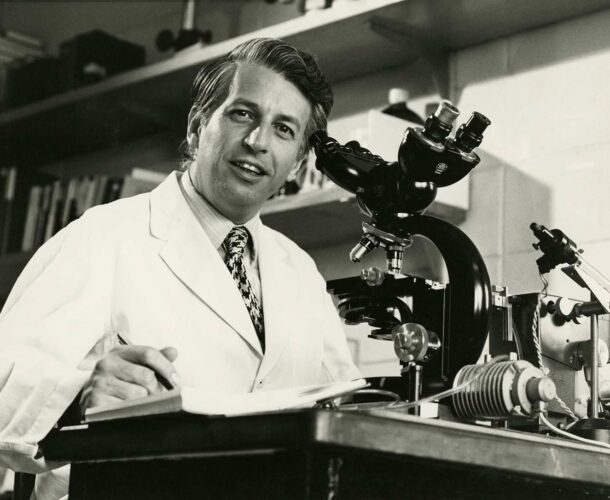In his 31 years as director, Nossal expands the institute’s size and research scope, attracts the best scientific minds from around the world and puts the institute on a firmer financial footing.
His outgoing personality and gift for communication make him one of Australia’s foremost advocates for science.
Sir Gustav Nossal’s reflections on his directorship
A few days before Christmas 1961, I came back to the Walter and Eliza Hall Institute from Stanford University to take up the newly created position of Deputy Director (immunology)… The shadow of Burnet’s retirement was looming large. He was such a dominant figure in the intellectual life of the institute that people wondered how the place could possibly go on without him after 21 magnificent years.
The first decade: 1965-1975
For reasons best known to the then board, it fell to my lot to try to fill these unfillable shoes.
My first actions were to broaden the base and improve the tools. Why broaden the base? For two reasons. I was not going to attempt to be as monolithic as Burnet, with essentially a whole institute formed around his ideas. Secondly, the skill and technical underpinning were inadequate. Following him like the Pied Piper, we had not developed the diversity of background skills and techniques which modern biology required.
The institute was intellectually strong, but physically run down. I immediately brought Don Metcalf out of his inadequate outpost near the hospital laundry into one of the two newly constructed floors, and made him assistant director.
I repatriated Jacques Miller from London to strengthen our position in cellular immunology. Then I promoted Gordon Ada to Unit Head to strengthen biochemistry. In 1968, Ken Shortman took over that important role. We were weak in anatomy and cell biology, so we brought in Tom Mandel to build an Electron Microscopy Laboratory…
Very critically in 1970, I had the good fortune of being joined by Jerry Adams and Suzanne Cory, who later built up our Molecular Biology Unit. I wish I could take all the credit for that startlingly important and successful move, but in fact, they chose us. Their arrival was wonderfully timed to capitalise on the gene cloning revolution, which broke just a couple of years later.
Within the Clinical Research Unit Ian Wood was followed by Ian Mackay, and a major era was born. I headed the Cellular Immunology Unit. Noel Warner headed immunogenetics, so within five years we had achieved a considerable diversification.
The second decade: 1975-1985
This consolidation phase was dominated by the success and growth of the various component parts. Given our larger research agenda, five and a half floors of the old Walter and Eliza Hall Institute were clearly not enough for our ambitions…
It was Don Metcalf who convinced me that we could not keep on applying Band-Aid solutions. We needed a new building and in 1980 the President of the institute, Sir Andrew Grimwade and I set out and convinced the Commonwealth and State Governments to fund the magnificent 15,000 sqm new institute, which was dedicated in 1985 and fully occupied in 1986.
The third decade: 1985-1995
What did the new institute allow us to do? There were three results.
There was an increased capacity for research training, with a doubling in the numbers of both postgraduate students and postdoctoral fellows. Secondly we had much better accommodation for our state-of-the-art technical services, which provide the glue that welds the institute together. Thirdly we now had the space and facilities to expand our clinical research…
Through the maintenance of a collegial, interactive atmosphere, we have somehow managed to accommodate emerging research fields and the ambitions of our younger stars without under-cutting the ongoing mainstream endeavours.






